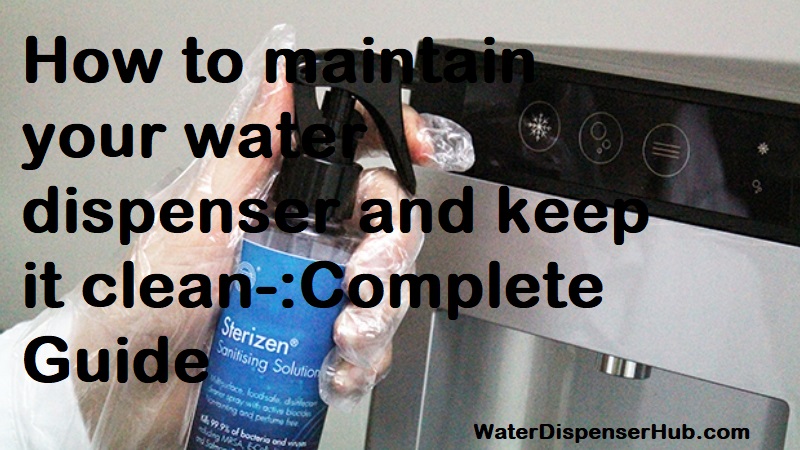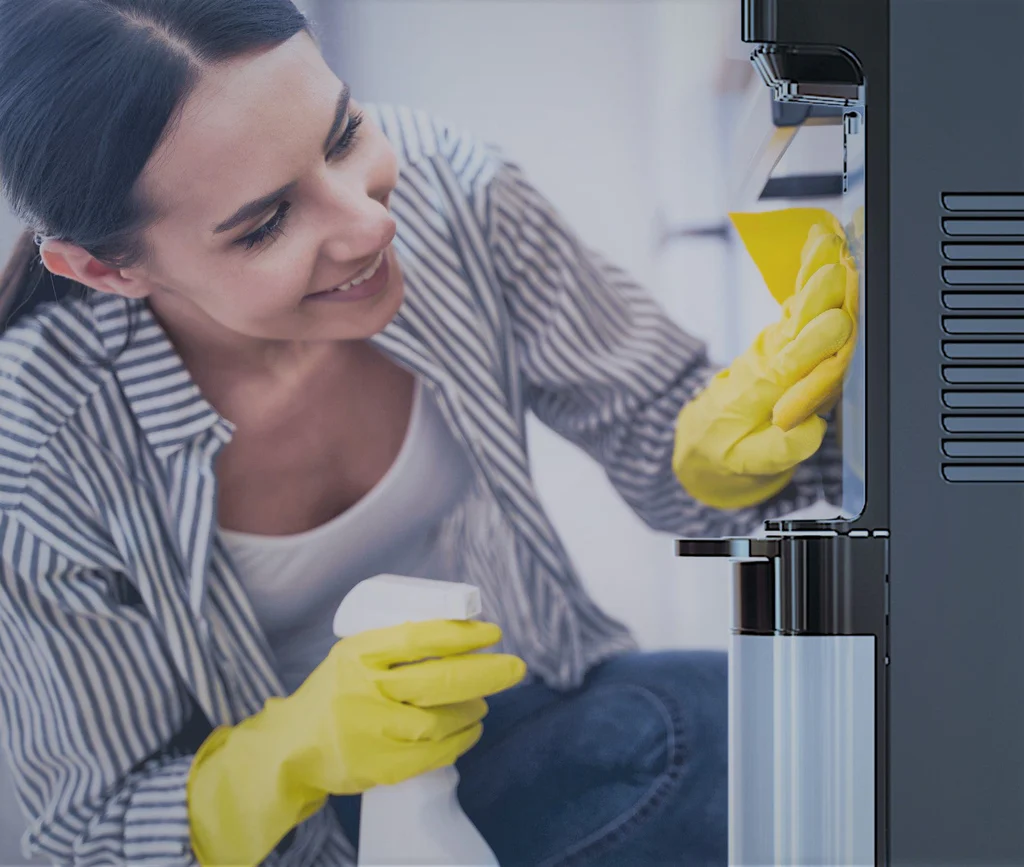Are you looking for a comprehensive guide to maintaining and cleaning your water dispenser? Look no further!
You need to take certain essential steps to ensure that your water dispenser continues to function properly. In this article we will discuss how you can maintain and clean your water dispenser to make sure it serves you hygienically safe, clean drinking water.
The water dispenser is a wonderful convenience. Being able to provide clean and refreshing water throughout the day at the touch of a button or the turn of a tap means that you can have healthy hydration options on hand whenever you’re thirsty.
However, with all appliances, there is a need for regular maintenance and cleaning to ensure that your dispenser continues to work properly and safely. In this guide, we will provide some tips on maintaining your water dispenser and keeping it clean.
It is important to regularly check for issues that may be causing problems, such as mold or debris buildup that could affect the performance of the system. Additionally, regular cleaning will help keep your Home Water Dispenser looking its best, giving off a pleasant scent whenever you need it!

Importance of maintaining water dispenser cleanliness
Maintaining the cleanliness and hygiene of your water dispenser is essential in ensuring that it performs its functions optimally, as well as protecting your health. With the emergence of coronavirus, it is especially important to keep surfaces clean and free from germs. This includes not only regularly sanitizing the water dispenser exterior and taps, but also replacing the water supply with fresh supplies on a regular basis. Doing this is necessary to avoid bacterial contamination and maintain a safe level of hygiene for both users and their surroundings.
Regular cleaning of the water dispenser is essential to ensure that there are no harmful bacteria or germs present in your drinking water. Accumulated dirt can also lead to clogging of pipes which can reduce the overall performance of your machine. Additionally, over time some parts may need to be replaced, so it pays off in the long run if you stay on top of regular maintenance and cleaning practices for your Dispenser!
Benefits of keeping water dispenser clean
Keeping your water dispenser clean is a necessity, as it will not only protect it from contamination and buildup of dirt, dust, and grime but also extend its life. Regular cleaning of the water dispenser will help reduce any odors or bad tastes in the water that comes out of it. Additionally, regular cleaning can extend the life of your water cooler by preventing possible damages due to accumulated deposits over time.
The most common way to keep a water cooler clean is to periodically disinfect the inside area with a clean cloth soaked in soapy water. This should be done at least once a week in order to eliminate any bacteria or mold growth that may occur within the system. Doing this regularly keeps your drinking and cooking water safe by removing potentially dangerous contaminants. For best results, you should use hot soapy water as cold water may not be able to break down all particles effectively.
It may also be necessary to clean out various components associated with the cooler often such as filters, faucets, etc., depending on their type of use and condition. Additionally, paying attention to minor details such as replacing outdated or used filters can help reduce strain on your cooler’s performance over time and help maintain quality drinking and cooking water for years to come.
Cleaning Schedule
Creating a cleaning schedule for your water dispenser can help you keep it running smoothly and efficiently. Here are a few tips on developing a regular cleaning schedule:
-Wash the water dispenser with warm, soapy water every two weeks or more frequently depending on usage.
-Remove the reservoir daily. Clean the interior with a soft sponge and then rinse well with hot water. Dry thoroughly with a soft cloth before returning to the cooler.
-Sanitize the inside of the reservoir every two to three months by using a store bought sanitizing solution such as bleach or vinegar and baking soda. Make sure to follow all package directions for dilution and contact time before rinsing thoroughly.
-Clean all external surfaces of the cooler routinely, including handles and faucets, to remove any build up of dirt or dust that could be spread throughout your house or office environment. Be sure to wipe down surfaces completely when done cleaning and also dry them completely with a soft cloth.
-Empty and clean drip trays daily if applicable. If these become clogged over time, run through some hot water with some white vinegar in it then wipe out before returning them to their positions under the spouts of the cooler.
Frequency of cleaning
The frequency of cleaning for a water dispenser depends on the type of water source you are using, as well as your daily usage. If you are using bottled water with your dispenser, you should clean it once a week to ensure optimal performance. In addition, it is also important to clean the interior any time you change the bottle.
If your dispenser is connected to a municipal water supply, cleaning it every two weeks should be sufficient. However, if there has been stagnant or infrequent use this timeframe can be extended and if you notice discoloration or an unpleasant smell coming from the faucet then you should immediately complete a deep clean.
Tools required for cleaning
Maintaining your water dispenser regularly can help to ensure it’s providing clean, safe water with no sediment or other contaminants. In order to perform the cleaning and maintenance properly, you’ll need the following items:
-Dishwashing liquid
-Hot water in a pot or kettle
-Clean non-abrasive cotton cloths/rags
-Soft sponge/scrub brush with non-scratch bristles
-Baking soda solution (equal parts baking soda and warm water)
-White vinegar
-Bleach solution (5 milliliters of bleach for 4 liters of clean cold water)
-Safety goggles
-Gloves
III. Cleaning Specific Parts of Water Dispenser
To help maintain your water dispenser and keep it free from unpleasant odors and other contaminants, all parts of your water dispenser should be cleaned at least quarterly. Be sure to check the manufacturer’s instructions before cleaning any part of the dispenser. Below is a list of commonly used and recommended cleaning solutions, tools, and steps to clean specific parts of a water dispenser:
-Doorline Tray: To clean the doorline tray, first empty it. Once emptied, use a soft brush or sponge with soapy water to remove any residue before rinsing with fresh warm water. Allow the doorline tray to air dry completely before replacing.
-Nozzle: First, turn off the power supply and remove any bottles from the nozzle connection before dismantling the nozzle from its housing cradle by unscrewing it. Then rinse each part thoroughly under running water for about 3 minutes before wiping them down with a lint-free cloth dipped in vinegar or soapy water solution. Allow them to air dry completely before reassembling and replacing them onto the housing cradle within their appropriate places.
-Cooling Taps: To clean cooling taps turn off any valves connected to cooling taps then open up each tap (hot/cold/room) individually and flush out sediment or debris until clear if present. Insert an appropriate sized pipe cleaner into each side of tap pipe inling hole(s) till end plate then rotate it around several times in both direction then removing each pipe cleaner when finished flushing hole(s).
-Reservoir Tank(s): Unplug your unit then unmount reservoir tank cover by loosening its screws if required then slowly draining out existing stored aqua until unit is empty then washing out reservoir tank using appropriate cleansers suffeciently as per requiremnted in conjunction with hot/warm soapy waters solution upon completion reinstall rservoir tank onto dispenser body refill proper amounts of aqua back into its filled chamber as necessary for intended operation purposes when concluded remount covers back onto respective locations when finished plug unit’s power supply back into electric socket if necessary.

Water reservoir
- Water reservoir
The reservoir of a water dispenser should be kept clean and regularly sanitized, especially for those with gravity-fed reservoirs. (Gravity fed water dispensers draw on the pressure from a tank above the spigot to force the water through the pump.) Fill and empty it at least twice weekly. It’s important to keep the water in the reservoir free from bacteria by disinfecting and cleaning it periodically, especially if you notice any discoloration or odor coming from your water. You can clean your reservoir by filling it with a gallon of white vinegar and 5 pounds of ice cubes; let it sit overnight before draining it in the morning. If you plan to use soap on your reservoir as well, use an unscented variety to avoid soap residues.
Drip tray
The drip tray at the bottom of your water dispenser can become clogged with dirt and debris, leading to unpleasant odors and worse. To keep your drip tray clean, it’s important to empty it every once in a while.
Begin by unplugging the power cord from its outlet and removing the filter door from either side of the machine. Lift up on either side of the filter door until it comes off – you may need to pull firmly –, then locate the drip tray drawer located inside and under where the filter door was just removed. Pull out this drawer slowly, as it is quite full of water when in use. Be careful not to splash water on yourself or other surfaces as you do this.
Once completely out, you can now safely empty any liquid that may have collected in the drip tray before returning it to its compartment beneath your unit. Replace both sides of your filter door by reversing what you did just before, then plug the power cord back into its outlet when finished.
Conclusion
Maintaining a water dispenser and keeping it clean is essential for the health and safety of all those who use it. In addition to frequent cleaning, taking certain measures like descaling and priming your cooler can help maintain its longevity and prolong its performance.
If you keep up with these simple maintenance steps, your water dispenser will stay clean, safe, and work perfectly for a long time.
FAQ’s
What maintenance does a water dispenser need?
Regular cleaning, replacing the filters, checking for leaks, and sanitizing are some common maintenance tasks for a water dispenser.
How do you clean a water dispenser naturally?
You can use a mixture of vinegar and water or lemon juice and water to clean a water dispenser naturally.
How do you clean the inside of a water dispenser bottle?
Mix a solution of water and dish soap, use a bottle brush to scrub the inside, rinse thoroughly, and allow to air dry.
Should I leave water dispenser on all the time?
It is safe to leave the water dispenser on all the time, but it may increase energy consumption and the chance of a malfunction.
How do I know if my water dispenser is dirty?
Foul odor, discoloration, and strange taste are some signs of a dirty water dispenser.
How long can water sit in dispenser?
Water can sit in a dispenser for up to 2 weeks, but it is recommended to replace it every 2-3 days for optimal freshness and safety.
What happens if you don’t clean your water dispenser?
A buildup of bacteria and other harmful contaminants can occur, which can lead to health issues and affect the taste and quality of the water.
Does dispenser purify water?
Some water dispensers come with built-in filtration systems that can purify water, but not all dispensers do.
Is dispenser water safe for drinking?
As long as the dispenser is clean and the water source is safe, dispenser water is generally safe for drinking.
What is the benefit of cleaning water dispenser?
Cleaning a water dispenser regularly can help ensure the water stays fresh and safe for drinking, prevent the buildup of harmful contaminants, and prolong the life of the dispenser.
See more-
- Best hot water dispenser 2023
- Best 5 gallon water dispenser 2023
- Best water dispenser with filter 2023
- Best bottleless water dispenser 2023
- Best water dispenser 2023

Robert Carlson is the CEO of waterdispenserhub.com and informative website, and a respected author in the dispenser industry. With years of experience and a passion for his work, Robert has become a trusted source of information for consumers and businesses alike. His dedication to excellence and commitment to providing unbiased and independent reviews have earned him a loyal following of readers who trust his expertise and insights. Robert is a true industry expert and a leader in the dispenser industry, and his work has been recognized by his peers and featured in various publications and media outlets.

